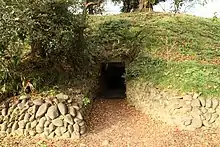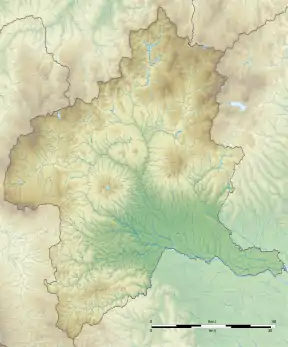Hachiman Kannonzuka Kofun
Hachiman Kannonzuka Kofun (八幡観音塚古墳) is a keyhole-shaped Kofun period burial mound located in what is now the city of Takasaki, Gunma Prefecture in the northern Kantō region of Japan. The site was designated a National Historic Site of Japan in 1948.[1]The site dates from the late 6th century, and many of the grave goods discovered during the archaeological excavation were designated National Important Cultural Properties in 1961[2]
八幡観音塚古墳 | |
 Hachiman Kannonzuka Kofun | |
 Hachiman Kannonzuka Kofun  Hachiman Kannonzuka Kofun (Japan) | |
| Location | Takasaki, Gunma, Japan |
|---|---|
| Region | Kantō region |
| Coordinates | 36°20′30″N 138°56′27″E |
| Type | kofun |
| History | |
| Periods | Kofun period |
| Site notes | |
| Discovered | 1973 |
| Public access | Yes (Museum nearby) |
Overview
The Hachiman Kannonzuka Kofun is located on a plateau sandwiched between the Karasugawa River and the Usui River, west of the city of Takasaki. Its main dimensions are:
- Overall length: 105 meters
- Rear circle: 70 meter diameter x 12 meter high
- Front width: 105 meters x 14 meter high
The tumulus is built in four tiers in the rectangular portion and three tiers for the circular portion. Unusually, the width of the rectangular portion is larger than the circular portion. The tumulus was at least partially surrounded by a moat. The 15.8 meter long horizontal burial chamber is made from stone megaliths, some measuring 4.5 x 3.4 meters, weighting over 50 tons, orientated to the southwest. The size of the megaliths used to make this chamber is also unusual, and the tomb is comparable to the Ishibutai Kofun in Asuka. The burial chamber was found to be intact when opened in March 1945 by locals who where building a bomb shelter and some 300 artifacts were discovered within. These grave goods included four bronze mirrors, gold, silver and glass jewelry, swords, spears, armor, horse harnesses, saddles, stirrups and Sue ware, Haji ware, and other containers of earthenware and metal. Two of the bronze mirrors were identical to those found in the Inariyama Kofun in Saitama Prefecture and must have been cast using the same mould. From these artifacts, the tumulus has been dated to the end of the 6th century to the beginning of the 7th century, and may have been one of the last of the great keyhole-shaped kofun to have been built in Gunma.
The recovered artifacts were found to be in good preservation, and many are displayed at the nearby Takasaki Kannonzuka Museum of Archeological Documents.
References
- "観音塚古墳" (in Japanese). Agency for Cultural Affairs.
- "上野国八幡観音塚古墳出土品" (in Japanese). Agency for Cultural Affairs.
External links
| Wikimedia Commons has media related to Hachiman Kannonzuka Kofun. |
- Takasaki City official site (in Japanese)
- Takasaki Kannonzuka Museum of Archeological Documents (in Japanese)